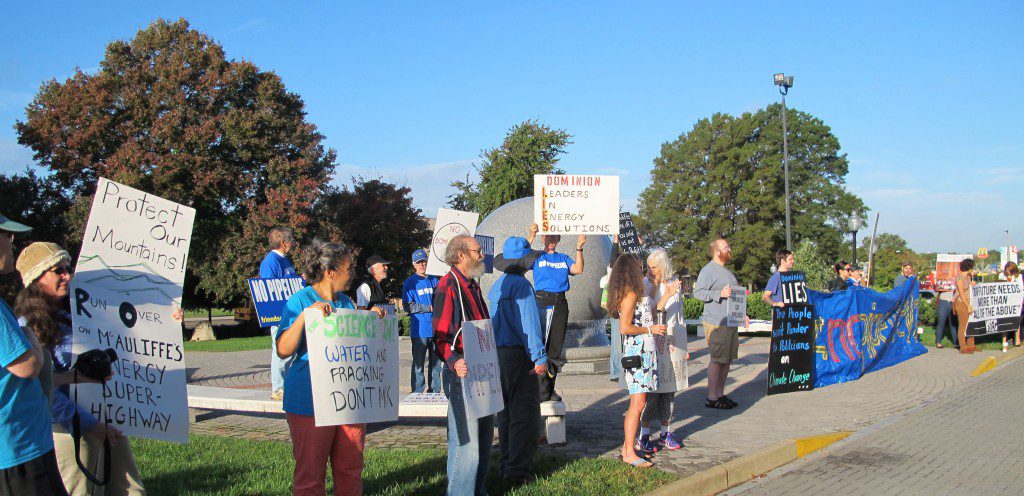McAuliffe Gives Briefing on Pipeline
Report from VNPS Conservation Chair, Maria Mabee Bell, on briefing by the Governor last week, including her comments at the end on what was NOT addressed.
Learn about petition to oppose: Chesapeake Climate Action Network
Last week, Virginia Governor, Terry McAuliffe unveiled his new energy plan at the Virginia Academy of Science in an event co-sponsored by the Virginia Chamber of Commerce and the Virginia League of Conservation Voters. The Governor stressed that his plan is an “all-of-the-above” approach to addressing the state’s energy needs, but with an emphasis on developing renewable resources and aggressive energy conservation. The plan was developed by the Virginia Energy Council, appointed by the Governor and staffed by the Department of Mines, Minerals and Energy (DMME). The council held six public hearings across the state over the past six months.
You can read the whole plan here: Virginia Energy Plan
In his remarks, Governor McAuliffe stressed that Virginia is facing a significant change in its economy because of the federal government’s imposition of sequestration cuts to defense spending. He said Virginia’s economy is highly dependent upon military spending and has suffered, and will continue to suffer declines in this source of revenue. The Governor wants to kick-start investment in a new economy. He said he views the energy plan as an important blueprint for achieving the needed economic diversity that will sustain and strengthen the state into the future.
Governor McAuliffe focused on the job opportunities within the renewable He foresees significant job growth from a strong investment in the renewable energy sector, particularly wind and solar. He wants to create a solar energy authority to match the current off-shore wind authority and sees job creation, for instance, in the production of wind turbines and other technologies that will be developed and built in Virginia. He foresees the same gains in jobs for solar energy. An important principle in the plan is a major investment in workforce training to support these technologies.
He said the state government will convert its transportation fleet to biofuels and other alternative fuels, and will change its contracting standards to build and retrofit its buildings to achieve energy cost savings. Importantly, the state will require similar energy efficiency contracting standards to be applied at the local level.
The Governor also noted that the energy plan will also support the development of “best-in-class” infrastructure (read: pipelines) for natural gas transmission. He related the need for increased access to low-cost natural gas to the polar vortex last year which nearly caused rolling brownouts across the state due to the sharp increases in demand. The energy demands are particularly high in Northern Virginia which the Governor said has more data centers than any other state and processes one-half of all the internet activity in the U.S. He also related the importance of improved access to natural gas for Southside Virginia which would then be able to attract businesses and improve job opportunities.
The Governor concluded his remarks by stressing that the plan is a work in progress, although the next action steps will be to submit it to the General Assembly for approval. He said his door is always open to anyone with a good idea to help Virginia move forward.
Following the Governor’s remarks a panel of stakeholders from various perspectives gave prepared comments on the energy plan. They were:
Conrad Spangler – Director, Department of Mines, Minerals and Energy
Steven Jumper – Director, Corporate Public Policy, WGL Holdings (Washington Gas)
Angela Navarro – Staff Attorney, Southern Environmental Law Center
Cynthia Adams – Exceutive Director, LEAP Virginia
Keith Togna – Global Lead, CEM, Honeywell Performance Materials and Technologies
Angela Navarro stressed the need for Virginia to focus on renewable energy sources and pointed out that Virginia is behind all the other six states her law firm serves, including Georgia and Alabama. Cynthia Adams stressed the impressive job creation and reduced energy costs associated with other states and jurisdictions that have instituted strong energy efficiency policies. Keith Togna stressed that for businesses to want to build manufacturing facilities in a state, or country, the most important factor looked at for energy is “no surprises.” He explained that means no surprises on cost or access now and going into the future. Other speakers noted the long history of instability of prices, and sometimes access, for fossil fuels. Steven Jumper ran through a lot of statistics that were hard to follow, but his thrust was natural gas transmission and distribution is a critical part of sustaining energy thirsty businesses and ran through a list of sectors such as agriculture to chemical companies. He said ensuring these sectors have access to plentiful and cheap energy is essential.
There was a brief question and answer session that was largely unremarkable. However, outside the building on a grassy area across the wide entrance driveway a group of 30 protestors held up signs opposing the large natural gas pipelines that, if built, will run across some of the most pristine environment in Virginia. Governor McAuliffe has expressed his strong support for these pipelines as part of his energy plan.
The issue of how “infrastructure,” that is, pipeline construction, might impact the environment by, for instance, destroying trees which are an important source for carbon mitigation, or by destroying biodiverse habitat, or by providing a ready avenue for introducing invasive species in pristine forest environments, was not discussed by Governor McAuliffe or the panelists.

